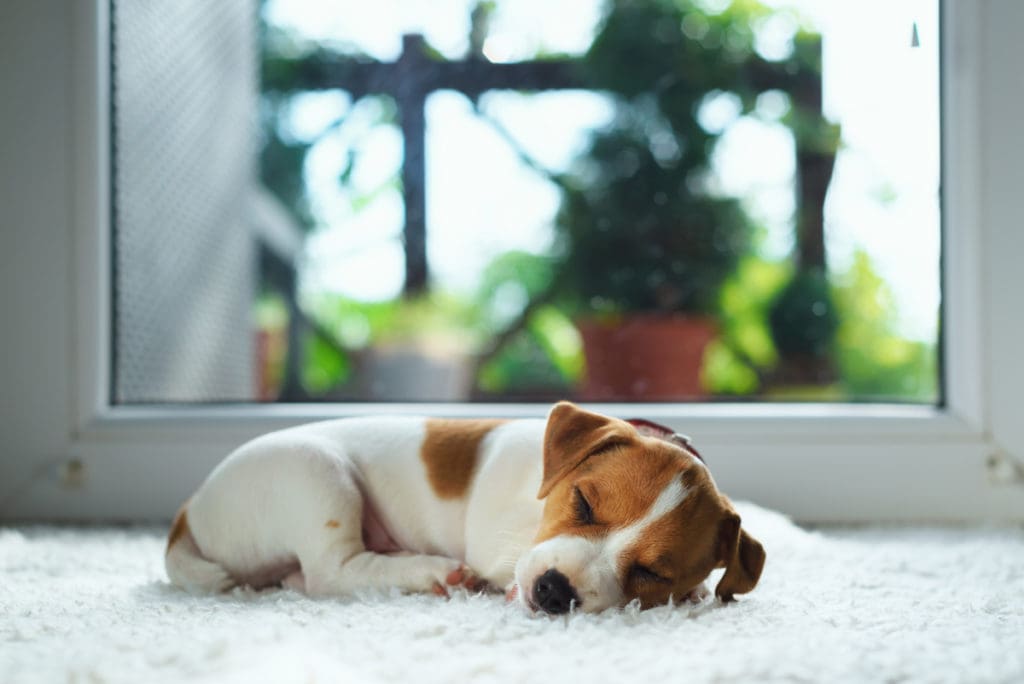Your puppy’s first few days
Bringing a puppy home can be a daunting experience for everyone, and especially so if this is the first time you will have had a dog in your family. Taking on a dog is a significant responsibility and you will want to do everything as well as you can. The following are a few tips to help make this a pleasurable and productive period for you and your puppy and lay the foundations for establishing a routine.

Feeding
Most people find it easier to feed puppies in their crate and your puppy will need to be fed four times a day.
It’s important to establish a routine with which both you and the puppy can be comfortable and, if you feed your puppy’s first meal no earlier than 6.30 am, and your puppy’s last meal no later than 6.30 pm, this will encourage a sleeping and toileting pattern/routine that gives them time to toilet before bed at night and encourages them to stay asleep/resting longer in the mornings. In busy families, the routine should allow you to fit in all the other requirements of the family day. The two meals in-between can be a time that fits with you but, ideally, should be fairly evenly spaced out between their morning and evening meals. This supports the toileting pattern that you are trying to establish.
Most puppies will arrive already established on the breeder’s food and may need to be weaned over onto your choice of food once they are settled. Unless advised otherwise by your veterinary surgeon, following the below weaning guide will give you a good idea on how to achieve this, with a process of reducing the breeder’s food and substituting your own food. This needs to be a gradual process to help the puppy’s digestion cope with the changeover:
| Breeder’s food | Your food | |
| Day 1 | 100% | 0% |
| Day 2 | 80% | 20% |
| Day 3 | 60% | 40% |
| Day 4 | 40% | 60% |
| Day 5 | 20% | 80% |
| Day 6 | 0% | 100% |
For more information on feeding your dog, click here.
Using a puppy crate
You may have seen some discussion about whether or not to use a crate for your puppy. To set the record straight, when used properly, a crate is not a place of punishment but is, instead, an ideal place where your puppy can feel safe and secure.
Your puppy’s mother will have been given a safe place in which to have and rear her pups, and providing your puppy with a crate to sleep in and where they can feel safe is a great way to start a lasting and loving relationship. At a time when everything will be new and different, it will provide a comforting reminder of the confined, secure place where your puppy spent their first few weeks. Over time, it will become your puppy’s own safe place where they can spend time resting, sleeping, or just watching how their new world works.
Click the link for more information on setting up and using a crate.
Sleeping
It is recommended that before you bring your puppy home, that you purchase a crate which your puppy will sleep in. The crate needs to be of a sufficient size to allow the puppy to grow but always to be able to stand, stretch out and turn around. You can purchase crate dividers which allow you to gradually increase the size of the crate as the puppy grows – this means that the crate is always an appropriate size. The crate should be lined with suitable, warm, comfortable and washable bedding, and some puppies prefer their crate to be covered with a blanket. Some breeders will give you a portion of some bedding from the place where the puppy’s mother and litter used to sleep, that you can also place in the crate. You can also provide the breeder with some of your own bedding that has been specially bought for the puppy, so that the litter can sleep on it before bringing it home with your puppy. Having something that feels and smells familiar may help your puppy settle in more quickly.
Always toilet your puppy before putting them in the crate. Not only does this minimise accidents that require you to wash bedding more frequently, but it also helps to establish the crate as a clean, secure place in your puppy’s mind.
Like small children, puppies have little concept of danger, so please don’t leave anything in the crate overnight when your puppy should be sleeping, other than their bedding and a water bowl. For the same reason, please remove your puppy’s collar if they are to be left in the crate when you are not available to supervise.
Location: You will have likely already decided where your puppy is going to sleep. Many puppies will struggle with being separated from their mother and siblings, being in a new environment, and now being separated from you. To avoid separation anxiety, it is recommended to have the crate in your bedroom for the first few weeks. You can plan to move the crate out of your room, and then downstairs (or where you intended to), once your puppy is comfortable and ready. Once you have put your puppy in the crate, please leave them alone and go to bed. Even if you do not cover the crate during the day, you can put a blanket over the top of the crate, if you wish, as this can make the crate more snug and cosy like a den for your puppy.
For the first few weeks, it is a good idea to plan to put the puppy to bed when you yourself are not particularly tired, with the anticipation that your puppy will not settle for 30 minutes. It can be a good idea to read in bed as this will give you a period of time for the puppy to settle quietly before you wish to go to sleep. You can then be happy that your puppy has settled. Watching TV or listening to the radio might suggest to the puppy that something else is worth investigating and distract them from settling down.
Toileting during the night: As outlined above, as your puppy will be sleeping in your room with you, throughout the night gently wake them up at regular intervals to take them outside to toilet. After they have, place them calmly back to bed without initiating any stimulating play or engagement. Over the next few weeks or months (depending on your puppy’s own pace), gradually increase the intervals from e.g. one hour, to two, to three, up until your puppy is sleeping through the entire night.
Should your puppy howl or whine, check that they are not uncomfortable (e.g. have their paw stuck in the crate) and calmly reassure them with your presence, such as by sitting with them or placing your hand nearby for comfort.
Toileting
Your puppy should be taken into the garden every time
- they wake up
- after they have eaten
- after they have had a good play
Young puppies need the opportunity to toilet every 30 minutes or so, however every puppy is different, and you will get to know your puppy’s habits and routine. In the early days, it can be helpful to keep a note of the time(s) when your puppy last toileted, especially if more than one person may be supervising the puppy throughout the day.
It is vital that you should ignore any accidents and reward all correct toileting in your garden with verbal praise and treats. Punishment never succeeds in effectively teaching your puppy.
Read more about establishing toileting habits.
Vets
Make sure that you register your puppy with your local vet on the day, or before, your puppy arrives as your vet will need the puppy to be registered with their practice before they can examine them.
All the information your vet will ask you about your puppy can be provided by your breeder, and your puppy’s health record is where everything health-wise should be recorded and should always go with them when you visit the vet.
It is important that you know where to take your puppy in case of an emergency. Some vets don’t operate 24/7 and they will give you details of the vets who do and who will accept your dog in that case.
For more information read more about the First vet visit.
Spending time with your puppy
In between meals, play time, and toileting breaks, allow your puppy to have plenty of rest. Try to provide your puppy with a quiet and calm atmosphere. One of the most important things they need to learn is how to be calm, and the best way they learn this is through imitation with us as role models and setting a calm environment.
Because your puppy needs to be vaccinated to provide protection from a series of unpleasant and sometimes fatal diseases, the puppy should remain in the house and garden until advised otherwise by your vet. Vaccination only provides full protection if the proper course is followed and the puppy is kept away from unprotected dogs and places where those dogs may have been.
After a couple initial weeks of settling in to their new home, visitors can come to see your puppy. Only do this in small numbers at a time. Ask the visitors to take off their shoes and wash their hands.
Don’t worry too much for the first few weeks about teaching them tasks in a structured manner. You need to get to know your puppy, they need to get to know you, and you need to work together to establish a routine.
Help support our life-changing work...
Imagine if everyday tasks were so challenging or physically demanding they affected your quality of life. For many people living with a disability of families with a child with autism, that is their reality. Now imagine if a specially trained four-legged friend could restore your, or your family’s, independence.
The demand for our services is high and we can’t help as many people as we would like to without more funding. Please help us continue to bring people and dogs together to help make everyday life possible in so many extraordinary ways.
Every contribution, whatever size, is important and helps us make a difference.

